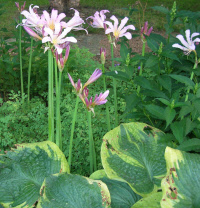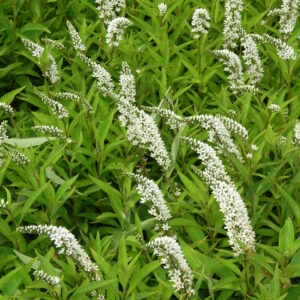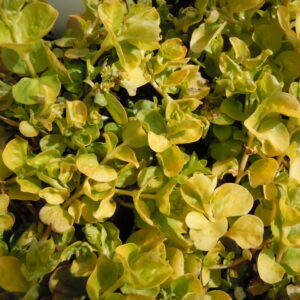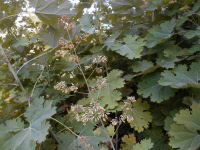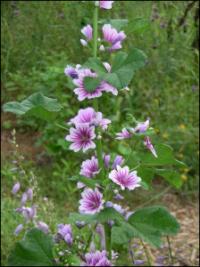Perennials & Biennials
- Sorry, this product cannot be purchased.
Showing 305–312 of 511 results
-
Lycoris squamigera Surprise lily, Naked lady Z 5-9
Strap-like leaves appear in April, then die back in summer. In August a shoot appears seemingly out-of-no-where, topped with pale pink trumpets. Flowers resemble Amaryllis.
Strap-like leaves appear in April, then die back in summer. In August a shoot appears seemingly out-of-no-where, topped with pale pink trumpets. Flowers resemble Amaryllis
Size: 18-24” x 6”
Care: full sun to part shade in moist well-drained soil
Native: JapanIntroduced to Western gardens from Japan in 1861 by Dr. George Rogers Hall (1820-1899), a physician who moved to Shanghai and became a trader, introducing several Japanese plants to the U.S.
-
Lysimachia clethroides Gooseneck loosestrife Z 3-8
Erect stems support gracefully arching goose neck look-alike from mid to late summer, deadhead to rebloom
Erect stems support gracefully arching goose neck look-alike from mid to late summer, deadhead to rebloom
Size: 36" x spreads
Care: sun to part shade in moist well-drained humusy soil
Native: China and Japan
Awards: England’s Royal Horticultural Society Award of MeritDioscorides (1st century A.D.) named Lysimachia after King Lysimachus of Thracia. Probably collected in Japan and introduced to the West by Swedish botanist Carl Peter Thunberg (1743-1828). Named and described in 1844.
-
Lysimachia nummularia ‘Aurea’ Creeping jenny Z 3-9
Bright yellow flowers in summer, chartreuse foliage
Bright yellow flowers in summer & chartreuse foliage which is the reason to grow this. Chartreuse is the little black dress, it goes with everything.
Size: 2” x spreading
Care: full sun to part shade in moist to moist well-drained soil
Native: Europe
Awards: England’s Royal Horticultural Society Award of Garden Merit.Dioscorides (1st century A.D.) named Lysimachia after King Lysimachus of Thracia. By the 1590’s used as cure for wounds and whooping cough. Species listed in Gardeners Dictionary, 1768. ‘Aurea’, H.H. Thomas 1915. Breck (1851) called this “suitable for rockwork or hanging from a pot in a northern exposure.” L.H. Bailey echoed this: “Very useful for rustic vases and baskets, also for carpeting ground in shady places.”
-
Macleaya cordata Plume poppy Z 4-9
An imposing plant - impressive, glaucous leaves with conspicuous veins and sculpturally jagged margins, and, from July to October brimming with tawny pink plumes.
An imposing plant – impressive, glaucous leaves with conspicuous veins and sculpturally jagged margins, and, from July to October brimming with tawny pink plumes.
Can not ship to: Delaware and Maryland
Size: 6-8' x 3' and spreading
Care: sun in well-drained to moist well-drained soil
Native: China and JapanEnglish seaman on Macartney’s Chinese mission sent this to Europe in 1792. In its native China the plant’s juice disinfected insect bites. Grown in American gardens since the 1800’s.
-
Malva alcea ‘fastiagata’ Hollyhock mallow Z 5-9
Bright rose mallows from early to late summer. Cut back by half in late July for rebloom.
OUT OF STOCK
Bright rose mallows from early to late summer. Cut back by half in late July for rebloom.
Size: 3’ x 18”
Care: Sun well-drained soil, drought tolerant
Native: ItalyMalvas have been cultivated for food or flower since 6000 B.C. In 1629 Parkinson described the uses for the Hollyhock mallow: “By reason of their viscous or slimie quality doe helpe to make the body soluble… helpe also to ease the paines of the stone and gravell, causing them to be the more easily voided: being outwardly applied, they mollisie hard tumors.”
-
Malva sylvestris ‘Zebrina’ Striped mallow – According to the books a perennial, but here it acts like an annual that reseeds – just watch for the seedlings in early summer. Z 5-8
June to October pink with purple striped mallow flowers
June to October pink with purple striped mallow flowers
Size: 36-48" x 24"
Care: Sun, moist well-drained soil. Moderately fertile.Malvas cultivated for food or flower since 6000 B.C. This Striped mallow was identified by Dioscorides in De Materica Medica for medicinal use around 70 A.D. Flowers and young leaves are edible – add petals to salads. The Malva sylvestris ‘Zebrina’ was listed as cultivated in the empire pursuant to Charlemagne’s Capitulare de Villis c. 800 A.D. The French word “mauve” comes from the color for this flower. Pressed specimen in Emily Dickinson’s herbarium.
-
Matteuccia struthiopteris Ostrich fern Z 3-7
Dissected, feathery fronds resemble ostrich plumes form vase-shaped clumps.
Dissected, feathery fronds resemble ostrich plumes form vase-shaped clumps.
Size: 3-4’ x 5-8’ spreading by rhizomes.
Care: part to full shade in moist well-drained to moist soil
Native: eastern No. America, Wisconsin nativeIn gardens since before 1790. Matteuccia is named to honor Italian scientist Carlo Matteucci (1811-1866.) Struthiopteris comes from struthio meaning “ostrich” and pteris meaning “fern.”The fronds are edible – Vermont adopted this as its state vegetable.
-
Melampodium leucanthum Blackfoot daisy Z 5-10
No fail low mounds of up to 50 small white daisies spring-fall, atop narrow, hairy, grey-green leaves
OUT OF STOCK
No fail low mounds of up to 50 small white daisies spring-fall, atop narrow, hairy, grey-green leaves
Size: 6-10” x 12-20”
Care: sun to part-shade in well-drained soil. Its tap root reaches down for moisture and hair on foliage protects if from desiccating winds and sun - xeric plant
Native: Colorado, Oklahoma, TX &AZ (no wonder it likes well drained soil) but perfectly happy as far north as 20° below zero in winter.
Wildlife Value: birds eat seeds –pollen and nectar attract bees and butterflies. Deer resistantBotany professor John Riddell found this in Texas, Described in Flora of North America, 1842.

